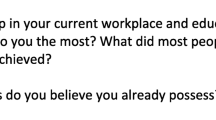Abstract
Working on quality improvement has become an innate part of managing a pediatric radiology service. To help radiologists effectively lead improvement teams, eight aspirational characteristics are discussed. These are: 1) Be a good listener, 2) Effectively communicate around an accountability cycle, 3) Stress simplicity: Prioritization and pace, 4) Expend energy to optimize people development, 5) Lead with optimism, 6) Create a culture of wellness and sustainability, 7) Have a progressive attitude toward failure and 8) Project humility over arrogance.
Similar content being viewed by others
References
Mann D (2010) Creating a lean culture – tools to sustain lean conversions, 2nd edn. CRC Press, Boca Raton, pp 3–103
Liker JK, Convis GL (2012) The Toyota way to lean leadership – achieving and sustaining excellence through leadership development. McGraw Hill, New York, pp 121–143
Bussell J (2012) Anatomy of a lean leader as illustrated by 10 modern CEOs and Abraham Lincoln. UL LLC, Northbrook, IL, pp 1–148
Sasscer M (2010) Accountability now! iUniverse, Bloomington, pp 1–108
Covey SM (2006) The speed of trust. Free Press, New York, pp 3–332
Donnelly LF (2014) Daily management systems in medicine. Radiographics 44:1209–1212
Donnelly LF (2016) The daily readiness huddle – a key component to a system of care. J Health Syst Policy Res 3:22.1–22.7
Donnelly LF, Dickerson JM, Lehkamp TW et al (2008) IRQN award paper: operational rounds: a practical administrative process to improve safety and clinical services in radiology. J Am Coll Radiol 5:1142–1149
Gordon J (2010) Soup. John Wiley & Sons Inc, Hoboken, NJ, pp 1–162
https://www.jjhpi.com/why-hpi/our-science. Accessed 8 Apr 2016
Syed M (2015) Black box thinking: why most people never learn from their mistakes – but some do. Portfolio/Penguin, New York, pp 1–294
Larson DB, Nance JJ (2011) Rethinking peer review: what aviation can teach radiology about performance improvement. Radiology 259:626–632
Riskin A, Erez A, Foulk TA et al (2015) The impact of rudeness on medical team performance: a randomized trial. Pediatrics 136:487–495
O’Boyle E, Aguinis H (2012) The best and the rest: revisiting the norm of normality of individual performance. Pers Psychol 65:79–119
Author information
Authors and Affiliations
Corresponding author
Ethics declarations
Conflicts of interest
None
Rights and permissions
About this article
Cite this article
Donnelly, L.F. Aspirational characteristics for effective leadership of improvement teams. Pediatr Radiol 47, 17–21 (2017). https://doi.org/10.1007/s00247-016-3689-5
Received:
Revised:
Accepted:
Published:
Issue Date:
DOI: https://doi.org/10.1007/s00247-016-3689-5




